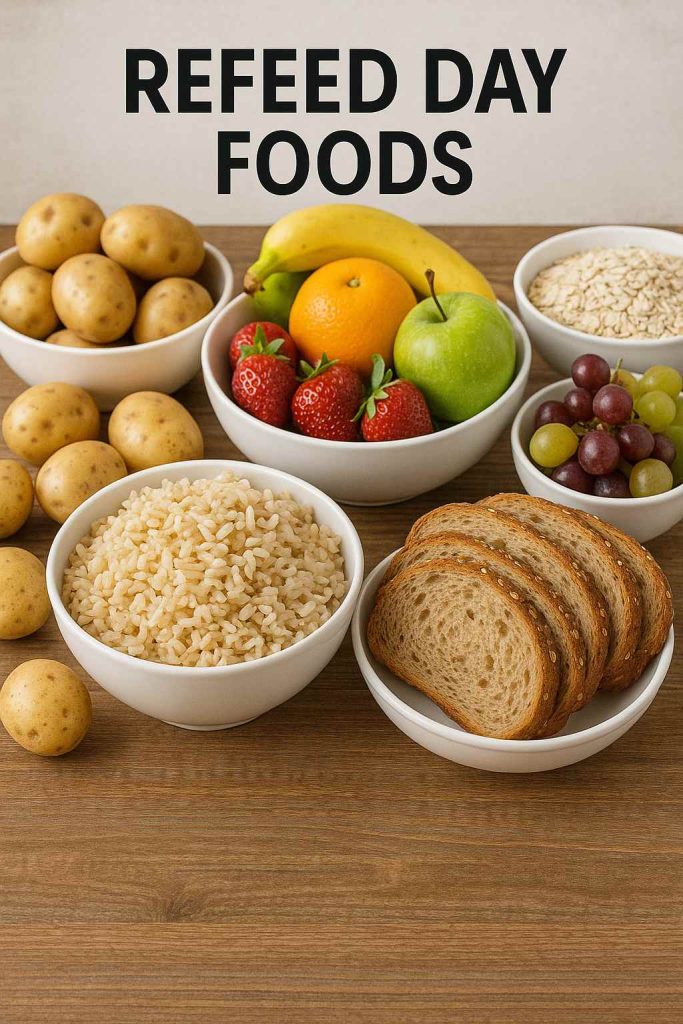A refeed day is a planned, structured increase in calories—mostly from carbohydrates—designed to boost metabolism, hormones, and workout performance during a calorie-restricted diet. If you’ve hit a weight-loss plateau or feel drained by constant dieting, understanding refeed days can help you break through and achieve your fitness goals.
Refeed days are not “cheat days”—they follow a strategic, controlled approach using healthy foods and accurate macros. Knowing how and when to use a refeed day helps you avoid diet burnout, maintain muscle, and keep losing fat, all while enjoying a temporary break from strict restriction. Below, you’ll find exactly what a refeed day is, why it matters, how to plan one, and the potential risks to consider.

For official guidance on diet breaks and nutrition, consult the Academy of Nutrition and Dietetics.
What Is a Refeed Day?
A refeed day is a short, scheduled period—usually one day—where you temporarily increase calorie intake, especially from carbohydrates, while keeping protein steady and possibly lowering fat slightly. The main goals are to:
- Raise leptin and other fat-burning hormones
- Refill muscle glycogen for better training
- Improve psychological well-being and diet adherence
Unlike a cheat day, a refeed is carefully planned to avoid excessive calories or junk food binges. You’ll typically eat at or just above your maintenance calories, prioritizing complex carbohydrates like rice, potatoes, whole grains, or fruit.
Key features of a refeed day:
- Lasts one day (sometimes up to two days)
- Focuses on clean, high-carb foods
- Slightly increases calories (20–30% above deficit)
- Keeps protein high, fat moderate or reduced
Learn more: Healthline – What Is a Refeed Day?
Benefits of Refeed Days
1. Prevent Metabolic Slowdown
Refeed days help boost leptin—a hormone that regulates hunger and metabolism. During long-term calorie restriction, leptin levels drop, slowing your metabolism and making further fat loss harder. A refeed can briefly raise leptin, helping you push through plateaus (Healthline, 2024).
2. Maintain Workout Performance
When dieting, depleted glycogen can leave you tired and weak in the gym. Refeed days refill muscle glycogen, restoring strength and endurance for better training sessions (NASM, 2024).
3. Preserve Muscle Mass
Studies suggest intermittent refeeds help maintain lean muscle during weight loss, especially if you’re training hard and eating enough protein (Naked Nutrition, 2024).
4. Reduce Diet Fatigue and Cravings
Structured refeeds make diets feel less restrictive, giving you a mental break and reducing the urge to binge. This increases long-term success and consistency (Working Against Gravity, 2024).
5. Support Hormonal Health
Besides leptin, refeed days may help normalize other hormones affected by dieting—such as thyroid and reproductive hormones—although effects are usually short-lived.
How to Do a Refeed Day
Step 1: Set Your Calorie and Macro Targets
- Calories: Eat at maintenance or up to 30% above your deficit.
Example: If your deficit is 1,700 kcal and your maintenance is 2,100 kcal, aim for 2,100–2,300 kcal. - Carbohydrates: Increase by 50–100% over your usual intake.
- Protein: Keep at usual levels (0.7–1g per lb of body weight).
- Fat: Slightly reduce if needed to offset higher carbs.
Step 2: Choose Whole-Food Carbs
- Brown rice, quinoa, oats, sweet potatoes, bananas, berries, whole-grain bread, pasta
Step 3: Plan Timing and Frequency
- Most people do a refeed once every 1–2 weeks.
- Very lean individuals or those training hard may benefit from weekly or even multi-day refeeds.
- Schedule refeed days on tough training or heavy workout days for maximum benefit.
Step 4: Track and Adjust
Monitor weight, energy, hunger, and workout performance after each refeed. Adjust frequency and carb amount as needed for progress.
For more on refeed day macros and timing, see IIFYM’s guide.
Risks and Limitations of Refeed Days
- Short-Term Effects: The leptin and metabolic boosts are temporary—often lasting less than 24 hours (Levels Protein, 2024).
- Risk of Overeating: Poor planning can turn a refeed into a binge day, undoing fat loss progress.
- Not for Everyone: People with a history of disordered eating should avoid rigid restriction/refeed cycles (MedicineNet, 2024).
- Limited Human Research: Most data comes from related dieting methods, not direct refeed studies.
Refeed Day vs Cheat Day
| Aspect | Refeed Day (Best Practice) | Cheat Day (Not Recommended) |
|---|---|---|
| Structure | Carefully planned | Unplanned, often binge-like |
| Calories | At/just above maintenance | Unrestricted, often excessive |
| Macros | Carb-focused, clean foods | High fat, sugar, processed foods |
| Benefits | Metabolic boost, glycogen | Usually only psychological relief |
| Risks | Overeating if mismanaged | Weight gain, diet setbacks |
Frequently Asked Questions (FAQs)
Q: Who should do a refeed day?
A: Refeed days are most helpful for people with low to moderate body fat, athletes, or anyone dieting aggressively for several weeks.
Q: How often should I have a refeed day?
A: Most benefit from a refeed every 1–2 weeks. Very lean or advanced trainees may need more frequent refeeds.
Q: Are refeed days necessary for weight loss?
A: Not necessary for everyone, but they can help prevent plateaus and improve well-being during long-term dieting.
Q: Should I do cardio or strength training on a refeed day?
A: Ideally, schedule refeeds on your hardest workout or heavy lifting days for best performance and recovery.
Conclusion
Refeed days are a smart, science-backed way to support fat loss, muscle retention, and workout performance during a calorie deficit. They provide both physical and psychological relief from dieting—if done correctly and in moderation. Track your progress, stick to whole-food carbs, and always listen to your body.
